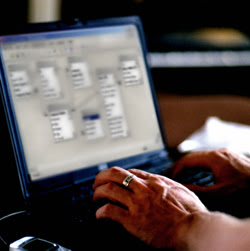 I
In order to understand what a
systems analyst is, you must first be familiar with and understand information systems, because as the textbook states: "a
systems analyst is responsible for designing and developing an information system."
Information systems are "collection of hardware, software, data, people and processes that work together to produce quality information." And in order to build an information system, a set of activities known as the system development cycle is necessary. These activities are grouped into five cyclical phases:
- Planning
- Analysis
- Design
- Implementation
- Operation, Support, and Security
Think of a
systems analyst like a middleman. There is a business goal that an organization needs to accomplish (such as a software program that allows employees to access and update certain types of records pertaining to their company.) The
systems analyst meets with the organization's managers and users to define specific goals of the system, and then design this system to meet the goals.
Along with management and users, the
systems analyst meets with IT professionals, vendors, sometimes other
systems analysts, but most importantly the steering committee (decision-making body of an organization.) In order for the variety of individuals and groups that the
systems analyst meets with during the system development cycle, the
systems analyst must possess strong communication, problem-solving, analytical and logical skills. They must be driven leaders who are detail oriented that have proficient organizational skills to enable them to successfully find solutions to problems/cumbersome tasks. They must think "out of the box," while grasping the big picture.
According to
The Princeton Review, some examples of questions that a
systems analyst must solve during the system development cycle are:
- What are the business requirements?
- Who will comprise the user community?
- How large is the application going to be?
- Will it be internal or external?
Do you ever feel overwhelmed because there a million different people pulling you in all different directions, all of which are asking you to do something for them? You start to panic and think, "Ahhh I cannot please and make everyone happy at the same time!" Well, that is a responsibility of a
systems analyst. It's possible. As with most things...it takes dedication and hard work.
Although we were given a peek into the life of a
systems analyst through the lecture segment interview with Christine Schoaff, here is a YouTube link that provides you with
"A Day in the Life of a Computer Systems Analyst."






